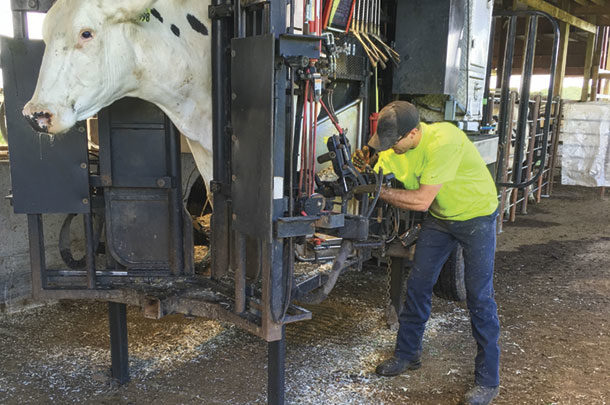Maintenance trimming.
It’s a common term tossed around when it comes to hoof-trimming schedules, but what is it and what does it mean? More importantly, how can a maintenance schedule decrease my overall cost associated with hoof health?
Let’s address the financial benefits associated with maintenance trimming, along with some other perks.
Maintenance trimming defined
Maintenance trimming is simply a normal trim that does not result in any extra treatments. This is what every producer should want, but how does it shake out for the cows? Do cows need one, two or more maintenance trims each lactation? The answer is different for most farms and most cows for that matter. The simple approach is to set up a given interval and trim all cows at a set time during lactation, or what we call maintenance trimming.
Every cow has different needs. I may trim a cow that has not been through the chute in a year, yet still has feet that are in good shape. The next cow in the chute may have been trimmed three months ago, yet she has long toes and is out of balance already. Because each cow has different needs, seeing them on a regularly scheduled basis is important.
I used to coach wrestling, and one of the principles I learned was this: Coach everyone the same, show everyone the same moves and coach everyone as if they are the top athletes. When done correctly, the less-skilled kids would improve and so would the advanced athletes. The reason for this was time. You simply cannot coach each student athlete individually, all the time, to their skill level.
I believe this same principle applies to our foot health programs. Some farms take the individual cow approach. If the feet look “good” upon observation as the cow leaves the parlor, she skips the trim; if a problem is observed, those cows are sorted off for trimming. In these scenarios, whether or not the cow sees the trimmer is a split-second decision.
An alternative approach is to make a list, sort those cows and get them trimmed. In the long run, this approach puts the herd in position for better foot health. Trimming each cow off a list produced on a dairy software program will also make the task easier and more efficient for employees.
Let’s talk cost
In today’s modern confinement dairies, foot health is an influential factor affecting profitability. Healthy feet can drive feed intake, improve fertility, reduce health costs, increase production and so much more. For the cost, not much comes close to its return on investment (ROI).
On my dairies, the average cost per hundredweight (cwt) is 12.5 cents. The range is from 11 cents to 14 cents.
Among my clients, the farm with the lowest cost per cwt was the first farm I had when I started my business. We have been on a maintenance trimming schedule of twice per year for most of my time there. They have the lowest lameness rate of all my dairies (around 1%-4%) throughout the year, in an environment that has more risk factors for lameness than my other dairies. We are able to trim more cows in less time, which both the herdsman and the cows appreciate.
Time is the most valuable commodity on any dairy, and its importance cannot be understated. The goal of every trimmer I know is to get as many cows that need attention trimmed adequately and to do so as efficiently as possible. One of the largest challenges trimmers can face when maintenance schedules are not followed is the inability to get all of the necessary trims complete.
This becomes an issue because when maintenance trimming is not done and cows are only trimmed one time per year, there’s often a lameness spike during late summer to early fall. When maintenance trims are pushed back or not done, the trimmer may run out of time in a visit to get every cow done, because more time is spent working on lame cows. I run into this a lot on farms where we trim one time per year – at dry-off. Because of the increase in lame cows in these situations, we cannot get the cows to go dry trimmed, resulting in cows not having their best feet going into transition. Keep in mind, trim time on a lame cow can and will take a minimum of three times longer to complete than a routine maintenance trim.
Additionally, those lame cows cost the dairy producer more. If your cost is $10 per cow, $20 per block and $5 for a wrap, that lame cow costs a total of $35 on trim day. I rarely see lame cows that have balanced toes, and that can be a huge factor in lameness. Furthermore, these cows often get out of balance because they have gone nine or more months without seeing the trimmer. If we trimmed each cow on a maintenance schedule, that one lame cow could have been trimmed 3.5 times for the cost of that one time through the chute.
Some farms may only need to be on a once-per-year trim schedule, while others may require two or even three trims per year. Discuss with your trimmer what he or she thinks suits your operation best. I am certain most will be open to doing more routine trims and doing less cattle with mobility issues.
By reducing lameness, we can certainly increase many things on our dairies. The importance of the way feet look and the way cows walk will only become more important as we move into the future. Consumers and processors will demand things be better than they are now. By working now to be proactive with the trimmer, veterinarian and nutritionist, you will be setting yourself up for success. For too long, hoof health has been a sector of the dairy farm that is reactive.
I encourage us all to try and change that. We can and we will, be it by our own choices or the mandates of others. Look into your costs; it will be different for everyone, but I am certain most every operation could find room for opportunity in the data.
We all want one thing: to have a profitable business our families can be proud of, and we need the cows to do it. By working toward a maintenance schedule, you will be positioned to experience benefits seen and unseen.










